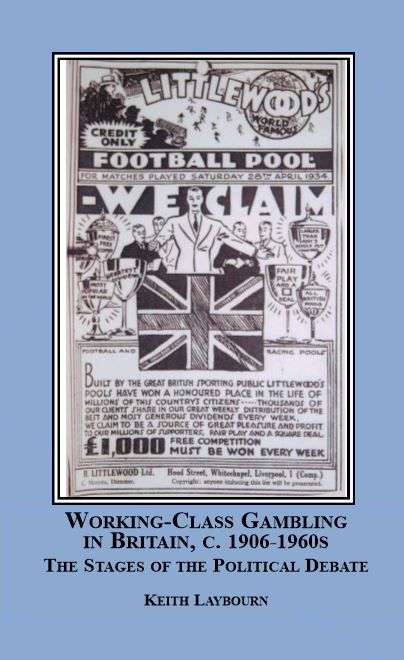Working Class Gambling in Britain c. 1906-1960s
We are currently unable to ship to the EU countries at this time. We apologize for this inconvenience.

| Author: | Keith Laybourn | |
| Year: | 2007 | |
| Pages: | 356 | |
| ISBN: | 0-7734-5374-1 978-0-7734-5374-6 | |
| Price: | $239.95 + shipping | |
| (Click the PayPal button to buy) | ||
Examines the class nature of gambling in Britain which made the off-course ready-money gambling of the working-class illegal while permitting the middle-class off-course credit gambling. It rejects the views of the National Anti-Gambling League that working-class gambling was an excessive waste of money and suggests that it was, by and large, ‘a bit of a flutter’ by the working classes. Using rarely used Home Office and police evidence, it suggests that both the police and the Home Office would have liked the Street Betting Act of 1906, and other restrictive legislation, removed since it was an impediment to good relations with the working classes upon which the police relied for evidence of serious crimes.
Reviews
“In the present volume, for which I feel honored in having been invited to write the Foreword, Dr. Keith Laybourn directs his attention away from institutions and leaders, and towards the customs and practices of ordinary men and women, for whom betting occupied a very important (if usually illegal) place in their lives.” – Professor Jeff Hill, Department of History and International Studies, De Montefort University
“This work is a marvelous and readable account that probes into the fascinating era of working-class gambling in late nineteenth- and twentieth-century Britain. This is a highly significant study of an important but relatively neglected subject. It brings important fresh perspectives, especially concerning class based attitudes towards gambling before the state made it legal and recognized part of the lives of many ordinary people in the 1960s.” – Professor John Shepherd, Anglia Ruskin University
“This is a well-researched and clearly argued monograph about gambling in the early- and mid-twentieth century. Professor Laybourn examines a range of topics in the history of gambling and gaming including the religious opposition to gambling, the activities of street bookmakers, the experience of the pools and greyhound racing, before moving on to the regulation of gambling and gaming from the 1930s to the 1960s.” – Professor Paul Ward, The School of Music, Humanities, and Media, University of Huddersfield
“This work is a marvelous and readable account that probes into the fascinating era of working-class gambling in late nineteenth- and twentieth-century Britain. This is a highly significant study of an important but relatively neglected subject. It brings important fresh perspectives, especially concerning class based attitudes towards gambling before the state made it legal and recognized part of the lives of many ordinary people in the 1960s.” – Professor John Shepherd, Anglia Ruskin University
“This is a well-researched and clearly argued monograph about gambling in the early- and mid-twentieth century. Professor Laybourn examines a range of topics in the history of gambling and gaming including the religious opposition to gambling, the activities of street bookmakers, the experience of the pools and greyhound racing, before moving on to the regulation of gambling and gaming from the 1930s to the 1960s.” – Professor Paul Ward, The School of Music, Humanities, and Media, University of Huddersfield
Table of Contents
Tables
Foreword by Professor Jeff Hill
Preface
Acknowledgements
Abbreviations
Brief Timeline
1 Introduction: An Overview of the Working-Class Culture of Gambling and Gaming
2 Religion and the Middle-Class Attack upon Working-Class Gambling: The National Anti-Gambling League, the Churches and the Anti-Gambling Campaigns, 1890s-1950s
3 Street Bookmakers 1906-1960s and the Changes after 1961
4 Posting the Pools and Going to the Dogs
5 From Prohibition to Acceptance and Recognition: Gaming, Lotteries, Draws, Whist and Premium Bonds: The 1934 Act and Subsequent Legislation c. 1930s-1950s
6 The Labor Party, Lotteries, Gaming and Bingo 1930s-1960
7 Conclusion
Bibliography
Index
Foreword by Professor Jeff Hill
Preface
Acknowledgements
Abbreviations
Brief Timeline
1 Introduction: An Overview of the Working-Class Culture of Gambling and Gaming
2 Religion and the Middle-Class Attack upon Working-Class Gambling: The National Anti-Gambling League, the Churches and the Anti-Gambling Campaigns, 1890s-1950s
3 Street Bookmakers 1906-1960s and the Changes after 1961
4 Posting the Pools and Going to the Dogs
5 From Prohibition to Acceptance and Recognition: Gaming, Lotteries, Draws, Whist and Premium Bonds: The 1934 Act and Subsequent Legislation c. 1930s-1950s
6 The Labor Party, Lotteries, Gaming and Bingo 1930s-1960
7 Conclusion
Bibliography
Index
